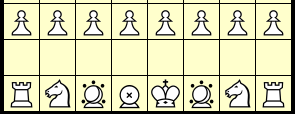[ List Earliest Comments Only For Pages | Games | Rated Pages | Rated Games | Subjects of Discussion ]
Comments/Ratings for a Single Item
It means you cannot move multiple pieces simultaneously.
And a Chieftain, which was 'activated' by another Chieftain, after it has moved can then 'activate' a piece(in the same turn) which has just fallen under its domain?
EDIT: Yes, this is a good tactic. Joe
 💡📝Joe Joyce wrote on Fri, Oct 24, 2008 05:19 AM UTC:
💡📝Joe Joyce wrote on Fri, Oct 24, 2008 05:19 AM UTC:Hi, Larry, John, thanks for the comments. John, you're right about how the pieces move. Larry, you seem to have it up to where you say the game is won by stalemate. There, I don't understand exactly what you mean. Most games end in resignation, or the capture of all of one side's leaders, along with the capture of some of the other side's leaders. There may be a fair number of the loser's non-leader pieces still on the board, unable to move. This time around, I'm working on pretty much a new class of variants, structured multi-move variants. I'm using 1 piece and 2 parameters to create the initial structures. The one piece is, of course, the leader, and the two parameters are how many pieces a leader can control, and how many squares that control extends across. I've just posted Chesimals, another pair of large multi-movers that use leaders with considerably different parameters, and it gives a truly different game. Here in the Chieftain series, a leader controls one piece, at a range of up to three. A chesimal leader controls [activates] about 10 chesspieces per turn, but these individual chesspieces that make up the one large AMP must be directly touching the leader unit, or a unit touching the leader, to move, so the leader's range is one square. All these games were originally worked out in the CV wiki. The two series of games just begin to indicate what can be done with the leader piece.
Well, if a player is unable to perform a move it is stalemate. And if all the Chieftains are captured, the player is unable to perform a move and again stalemate. So, the game is won by stalemate. Which is a fine ending. Trying to work out the dynamics so I might hack out a Zillions implementation of Superchief. Handling the multi-moves will be tricky, especially determining which Chieftain is responsible for which move during the turn. Possibly assigning each Chieftain a seperate name, such as Chieftain A, Chieftain B, etc. Thus the player can select the appropriate one to assign responsibility for the move, particularly when it is possible that two or more could be. But the names will not restrict the order in which these moves might be made.
 💡📝Joe Joyce wrote on Fri, Oct 24, 2008 04:15 PM UTC:
💡📝Joe Joyce wrote on Fri, Oct 24, 2008 04:15 PM UTC:Larry, that would be great if you can manage it. A Zillions implementation of this game, I might just be able to win! The game, like Go, clearly scales - I've posted a 12x8, 12x16, and 12x24 version. The scaling has the same effect as in Go, also, with the larger games having more strategic depth. I also admit to being tempted to bring it up to 12x32 and 12x48. The largest size should present an interesting effect of players each winning on opposite ends of the board, having to change direction 90 degrees, regroup, and attack again to win. How big is too big to be playable? To an extent, it depends on the piece mix. I found that the 12x24 Superchief is easily playable with 5 different piece types, but the 15x30 Overlord is somewhat harder to play, more because it adds 2 new piece types, for 7 total, than because it adds 2 leaders to Superchief's 6, to allow 8 moves per turn. So a 12x48 using the 5 original [shortrange, thus easy to see attacks coming] pieces should be playable without too much difficulty. Probably the hardest part would be trying to see the entire board at once, for overall strategic planning. [These games cry out for face-to-face team play. Or a 1 vs 8 game.]
Just posted: StrategiChess. Note the similarities and differences.
7 comments displayed
Permalink to the exact comments currently displayed.
